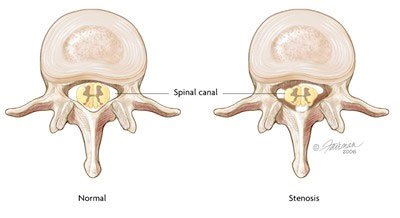Spinal Stenosis Treatment & Surgery in Milwaukee, WI
What is Stenosis?
Spinal stenosis is a narrowing of the open spaces within your spine, which can put pressure on your spinal cord and the nerves that travel through the spine. Spinal stenosis occurs most often in the lower back (lumbar stenosis) and the neck (cervical stenosis). This condition causes various symptoms depending on the location and severity. While some people have no signs or symptoms, spinal stenosis can cause pain, numbness, muscle weakness, and problems with bladder or bowel function.
Spinal stenosis is most commonly caused by wear-and-tear changes in the spine related to aging. In severe cases of spinal stenosis, doctors may recommend surgery to create additional space for the spinal cord or nerves. Some people are born with a narrow spinal canal – known as congenital stenosis – but most cases are considered acquired spinal stenosis, resulting from degenerative changes over time.
Left untreated, spinal stenosis may worsen gradually, causing permanent nerve damage. Advanced imaging – such as MRI or CT scans – is essential for diagnosing the location and severity of compression so the right spine procedures can be chosen.
Living with spinal stenosis can limit your mobility and impact your daily routine – but expert care can make a life-changing difference. Dr. Branko Prpa is widely regarded as the best doctor for spinal stenosis in the Milwaukee area. He specializes in minimally invasive spinal stenosis surgery, using the latest techniques to relieve pressure on the spinal cord while preserving stability and reducing recovery time.

Spinal Stenosis can cause the following:
Symptoms vary widely depending on where the narrowing occurs. Common signs include:
- Radiating pain in the legs or arms
- Tingling or numbness in extremities
- Cramping, muscle weakness, or fatigue
- Difficulty standing or walking
- Bowel or bladder issues in advanced cases
Cervical stenosis can interfere with upper body strength and balance, while lumbar stenosis often causes sciatica-like symptoms, including leg pain that worsens with standing and improves when sitting or leaning forward.
Sciatica – pain that radiates along the path of the sciatic nerve — which branches from your lower back through your hips and buttocks and down each leg. Typically, sciatica affects only one side of your body. There are many causes of sciatica.
Neurogenic intermittent claudication – Leg fatigue and/or weakness and leg numbness and/or paresthesia.
Pain
- Bilateral leg pain with burning or cramping. Involves buttocks and thighs and spreads to the feet.
- The neural canal and neural foramen are narrowed with the spine in backward extension and opened in forward flexion, neural compression is usually intermittent and provoked by lying prone or extending (arching) the lumbar spine, and when upright, particularly when walking.
- Cycling does not usually cause significant problems.
- The pain is usually relieved by sitting, leaning forward, putting the foot on a raised cushion or stool, or lying supine.
Cauda equina compression
- Caused by any narrowing of the spinal canal that compresses the nerve roots below the level of the spinal cord.
- May be due to trauma, disc herniation, spinal stenosis, spinal neoplasms, inflammatory or infectious conditions.
- Features of cauda equina compression include low back pain, unilateral or bilateral sciatica, saddle and perineal anesthesia, bowel and bladder disturbances, and weakness, sensory deficits and reduced or absent reflexes in the legs.
Surgical and Non-Surgical Treatment Options for Spinal Stenosis
For many patients, conservative treatments can provide relief. These may include:
- Spinal stenosis exercises guided by physical therapy
- Pain-relieving medications or spinal injections
- Bracing to reduce pressure on affected areas
When symptoms are severe or progressive, severe spinal stenosis surgery may be required. Dr. Prpa offers:
- Decompression procedures to relieve nerve pressure
- Spinal fusion surgery to stabilize the spine if needed
- Minimally invasive options that minimize muscle disruption and downtime
In some cases, lumbar spinal stenosis surgery may be needed when narrowing occurs in the lower spine, often leading to radiating leg pain or mobility issues. There’s also cervical spinal stenosis surgery, which addresses compression in the neck, possibly affecting coordination, arm strength, or balance.
As a leader in spinal stenosis surgery in Milwaukee, Dr. Prpa customizes every plan based on imaging, symptom severity, and patient goals.
Recovery and Long-Term Management
Recovery depends on the procedure but often includes physical therapy and activity modifications. Patients undergoing minimally invasive spine surgery can usually return to light activity within a few weeks, with most seeing ongoing improvements for several months.
Ongoing follow-up visits and simple lifestyle adjustments – like posture correction, core strengthening, and regular exercise – are key to protecting your spine and reducing the risk of future complications.
Why Choose Dr. Branko Prpa for Spinal Stenosis Surgery?
Patients choose Dr. Prpa because he combines surgical precision with a personalized care experience. His expertise in both traditional and minimally invasive spine procedures sets him apart in southeastern Wisconsin.
If you’re living with spinal stenosis and ready to explore your options, schedule a consultation with our team today and take the first step toward lasting relief.
